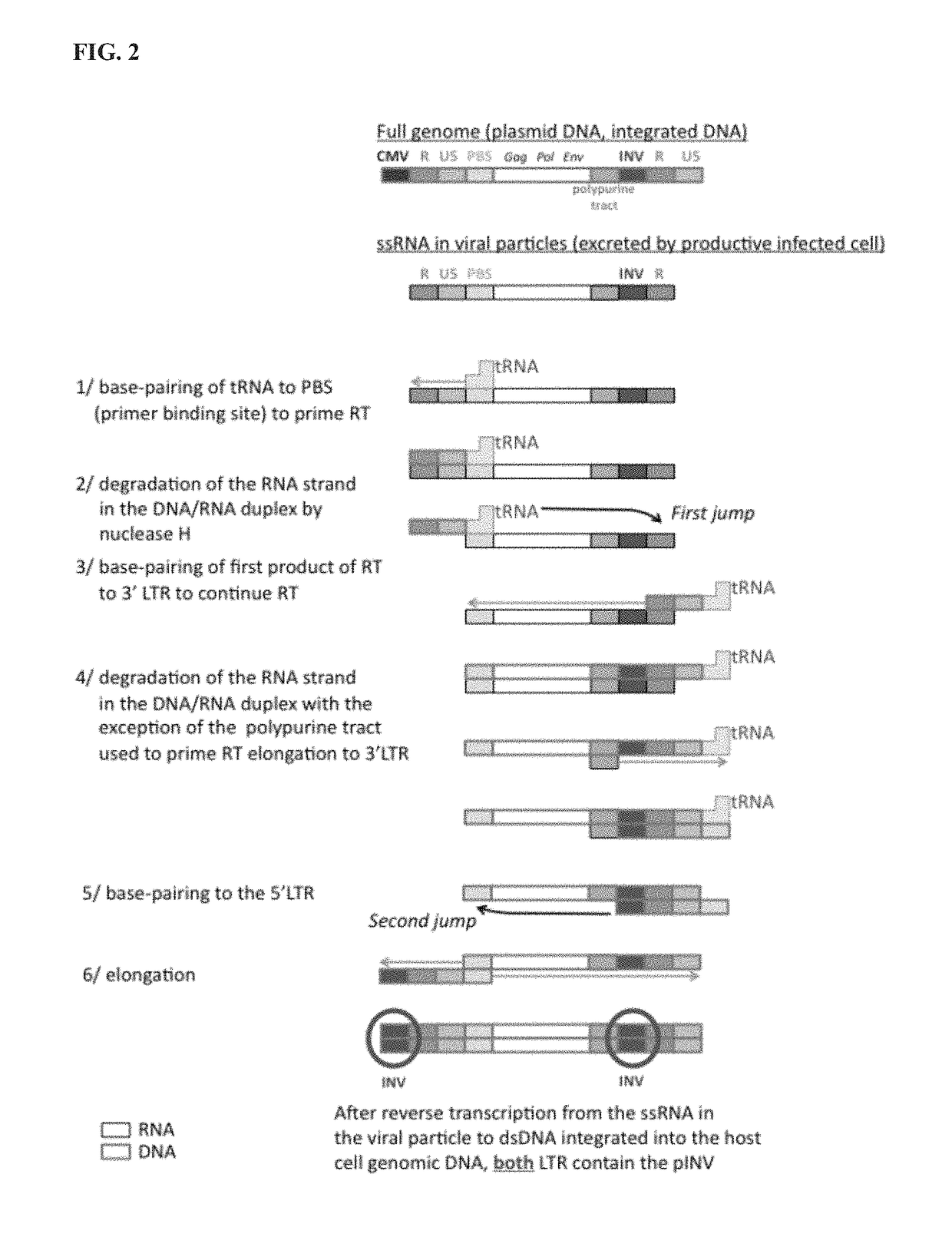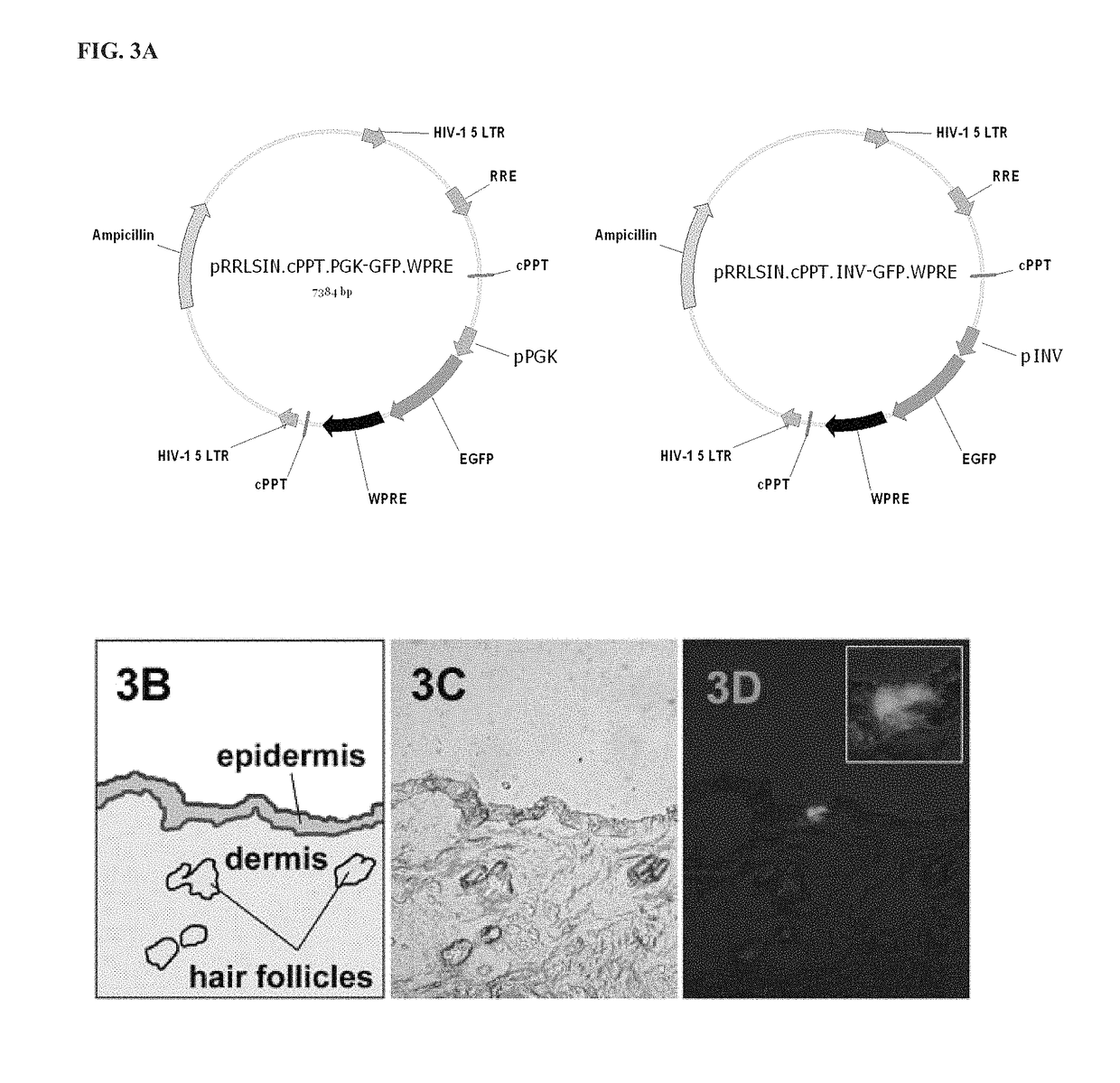Involucrin-driven retroviral expression cassettes encoding human immunodeficiency virus envelope glycoproteins
a technology of immunodeficiency virus and envelope glycoprotein, which is applied in the field of immunodeficiency virus envelope glycoprotein and its use in the development of vaccines, can solve the problems of continuous release of antigen, weak and transient protection at best, and safety issues preclude the use of live attenuated siv vaccines in humans, and achieves a strong barrier to viral replication and prolonged stimulation of the immune system
- Summary
- Abstract
- Description
- Claims
- Application Information
AI Technical Summary
Benefits of technology
Problems solved by technology
Method used
Image
Examples
example 1
n of Constructs
[0070]FIG. 1 is a schematic representation of the different constructs used as starting materials in one embodiment of the invention. FIG. 1A is a representation of the full-length SIVmac239 genome and encoding regions. FIG. 1B is a representation of 3′-half of SIVmac239 (p239SpE3′) and of 5′-half of SIVmac239 (p239SpSp5′) plasmids obtained from Ronal Desrosiers (NEPRC, Southborough, Mass.) used as starting material to set up the different constructs. FIG. 1C is a representation of SIVmac239-STR and SIVmac239-EF1a / STR plasmids, lacking portions of the 5′U3 regions in both LTR (termed STR for “short terminal repeat,” instead of currently used LTR for “long terminal repeats” for retroviruses), FIG. ID is a representation of SIVmac239-EF1a / STR / IRES-GFP plasmid where Nef gene has been deleted by insertion of an IRES-GFP region between positions 9500 and 9690 in SIVmac239-EF1a / STRconstruct. This insertion has been performed using the XhoI restriction site within the Nef ge...
example 2
of Provirus
[0071]FIG. 2 is a schematic representation of the formation of proviruses from the pCMV- and the pInv-driven constructs. The full length SIV constructs were generated as plasmids containing full length 5′-LTR with the CMV promoter in lieu of their 5′-U3 region in both pCMV- and pInv-driven constructs, and either the CMV promoter or the involucrin promoter in the U3 region of their respective 3′-LTR. The messenger RNA molecules contained in the VSV-G pseudotyped viral particles after co-transfection of the full length SIV constructs with the pL / VSVG lack the pCMV promoter corresponding to the 5′-U3 region and the 5′-U5 region of both constructs. As a result of the reverse transcription and double stranded molecule formation of pro viruses after infection by VSV-G pseudotyped viral particles depicted in FIG. 2, the pINV-driven construct integrated as double stranded DNA molecule and was used for SIV protein production by infected cells has both restituted complete LTR with ...
example 3
romoter Activity Assay
[0072]Involucrin is a well-characterized differentiation marker in keratinocytes. When used to generate transgenic mice, minimal human involucrin promoter driven construction leads to the expression of reporter gene in the upper part of epidermis. Transduction of the epidermis in mice by topical application of an involucrin promoter driven vector leads to the expression of the reporter gene into the upper strata of the epidermis. To test the efficacy of the involucrin promoter constructs of an embodiment of the current invention, in vivo promoter activity assays were performed in mice. Mice were inoculated via the epidermal route a transcriptional activity reporter plasmid where the GFP encoding region is under the transcriptional control of the involucrin minimal promoter (pRRL.SIN.cPPT.pINV-GFP.WPRE) (FIG. 3A). One week after inoculation, mice were euthanized and skin samples were frozen, prepared for histological analysis and visualized by fluorescent micros...
PUM
| Property | Measurement | Unit |
|---|---|---|
| concentration | aaaaa | aaaaa |
| concentration | aaaaa | aaaaa |
| concentration | aaaaa | aaaaa |
Abstract
Description
Claims
Application Information
 Login to View More
Login to View More - R&D
- Intellectual Property
- Life Sciences
- Materials
- Tech Scout
- Unparalleled Data Quality
- Higher Quality Content
- 60% Fewer Hallucinations
Browse by: Latest US Patents, China's latest patents, Technical Efficacy Thesaurus, Application Domain, Technology Topic, Popular Technical Reports.
© 2025 PatSnap. All rights reserved.Legal|Privacy policy|Modern Slavery Act Transparency Statement|Sitemap|About US| Contact US: help@patsnap.com



